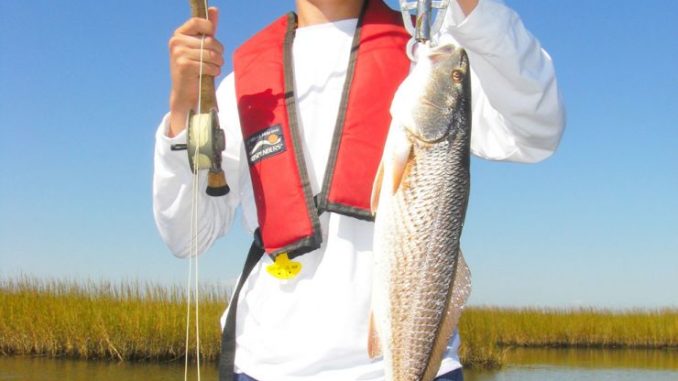
It’s a great month for newbies to stalk their first poisson rouge
Lately I’ve been enjoying the new “Jack Ryan” television series. Based on the novels by Tom Clancy, Ryan is a CIA analyst-turned-operative who is called upon to save our country from various enemies.
Several movies have been made on the Ryan novels. The first was “Hunt for Red October” in 1990, with the character played by Alec Baldwin. It was a box office smash.
Inspired by that movie name, there have been several articles over the years entitled, “The Hunt for Reds in October.” Each article has pointed out that (a) targeting marsh redfish is more like hunting than fishing, and (b) October is prime time for catching reds on the Gulf Coast.
And while those points are valid, I take a different approach. Rather than just hunt reds, I haunt them.
How do you haunt a fish? Simple. As you release it back in the water, you whisper in its ear — or whatever ear it does have — the following: “More like me are coming.”
I don’t know if that gives a redfish nightmares or not — but it should.
Scary times
One reason for the spot-tail Elvis to be nervous this month is because much of what shrouds its presence is disappearing.
As the cool fronts of October push through our marshes, they lower the flood tides of late summer. This also forces bait out of the spartina grass, and gives them a buffet to feed on. Often their aggressive feeding will give them away.
And as water temps lower, suspended organics begin to drop out. Clarity can increase in marsh ponds from a few inches to a couple feet within weeks. It definitely makes it a lot easier to spot the pumpkins.
A Hallows’ Eve prep
My threat to the poisson rouge is not an idle one.
Take my nephew Kurt. A few years ago, I introduced him to the wonders of marsh fly fishing. Appropriately, on a Halloween trip.
In preparation for the trip, we practiced some casting on a nice, windy day. After all, it’s never calm in the marsh — except on weekdays.
I placed several hula-hoops from 20 to 40 feet away and about 10 to 15 feet apart.
We then did an exercise called “playing the clock.” From a marker representing the 12 noon position, I would bark out various clock positions relative to each hoop. For example, “3 o’clock” meant a fish 45 degrees to his right. The goal was to make the cast to the hoop with only one false cast, and not overline the hoop.
We followed with hook-setting and fish-fighting practice. This involved me pretending to be a fish, pulling on the end of his line and moving from side to side. All in an effort to keep tension constant.
Dark shadows
The day of the trip, we did a roadside launch with my canoe. Kurt took the front, while I poled from the rear.
The water was a tad murky, so I began looking for dark figures. Didn’t take long until I spotted a red a few feet off a bank, cruising slowly to the right.
Our practice session paid off. Rather than cast to the fish — which was at 10 o’clock — I told him to cast at 11 o’clock. The black LaFleurs Charlie hit near the bank. I said, “Let it sit.” Then we waited a few seconds until the fish was inches away.
At that point, I ordered Kurt to begin making short strips. As soon as he did, the red darted towards his fly. Kurt felt the tension, and just as we practiced, he set the hook and battled the fish, moving the rod tip side-to-side so as to avoid slack and keep leverage on the fish’s head.
Shortly, Kurt brought his shiny red prize to the net: The first red he’d ever caught on fly.
The great pumpkin
Nothing brings more joy than seeing a newbie hook their first red.
I recall when another nephew of mine, Ira, made his maiden marsh fly fishing trip. We were fishing specks in a canal when a large series of crashes came from behind a cut.
I put us in position and waited. Suddenly it rose on the edge of a grass island: A big bright orange fish glowing like a pumpkin.
Ira did everything right — perfect fly placement, a good hookset and keeping proper tension during the fight. When the fish made a run, he used the reel’s drag while slightly palming the reel rim.
But just as I was bringing the net, Ira broke a cardinal rule: He let the line go slack, and the great pumpkin spit the hook.
When the fish gets near the boat, it’s better to swim it around than to let tension off — especially with a barbless fly.
Since then, Ira has caught numerous reds on fly rod. But that one was special. The first one always is — even if it gets away.


